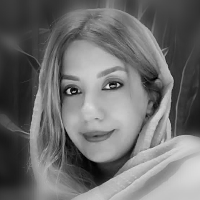Stylistics of “Tasheir” in Tabriz School II
Author(s):
Article Type:
Research/Original Article (دارای رتبه معتبر)
Abstract:
Definition of Tasheir is rarely mentioned in ancient sources. The book "Golestan Honar" states: "When the pen is taken up by the secretary for Tasheir, hair rises on the lion's body" (Munshi Qomi, 1352, 138). This verse refers to two important features of “Tasheir”, namely the elegance of the pattern, the thinness of the hair, and the use of animal motifs. In new sources, we read in the sense of Tasheir: "Literally the word “Tasheir” means hair, and in religious terms, a kind of gilding, such as Khatai and images of very small animals and birds, which are usually painted with gold and sometimes with other colors". In addition to animal and gold motifs that differentiate Tasheir from the perspective of motif and technique, the theme can also be examined in its formation, as a single vineyard. Tasheir has intricate and thin motifs and includes Arabesque, Khatai, catch and hunting lines. The samples used in this research are seven versions of Tabriz school named Divan Khataei, Khamseh Jami, Al-Anwar Khajavi Kermani shrine, Khamseh Tahmasebi, Zafarnameh Teymouri, Golestan and Bustan of Saadi which are purposefully selected and the best margins of Tasheir are studied in each version. The variables, one to two samples, are examined in a total of nine samples. Style is a literary word and it is synonymous with expressions such as: melting, molding, melting gold and silver, special ways of speaking, prose, style, method, style, way, way and suchlike. In the definition of style, it is considered as a way of dealing with problems and the result of perception of problems that in addition to the emergence of emotions and feelings can bring intellectual, scholastic, philosophical, emotional and even humorous attitudes. The term was first used to describe the methods of speaking in literature and then in the realm of art. In art, style can generally be thought of as distinct patterns or attributes of something or a set of objects. These specific patterns or attributes are called stylistic characteristics or attributes. Now, if these attributes are in a work of art, it can be the style of that work, if it is in the works of an artist, it can be the style of that artist, and if it is in the works of a region or a period, it can be the style of that region or period. Some consider the origin of poetry to be Chinese, which has found its way into Iranian art with the introduction of colored decorative papers. Since the Iranian book layout has always benefited from the text and margins, examining the margins of the drawings, especially the “Tasheir”, provides more information. “Tasheir” played an important role in decorating the margins of texts and paintings from the ninth century AH onwards and reached its peak of beauty in the Safavid period with the birth of the schools of Tabriz II, Qazvin and Isfahan, and this has doubled the need to address it. This study aimed to answer this question with the aim of mastering the stylistics of “Tasheir” in the early Safavid period. What are the characteristics of mourning in the second school of Tabriz in terms of engraving, decoration technique and concept, and what were the types of Stylistics of Tasheir in of this school? About characters of Stylistics of Tasheir in Tabriz school II, these issues are considerable: the research is of a fundamental type and with a descriptive-analytical method based on the historical approach and observation of selected samples and collection of library information. The result is that in the “Tasheir” of Tabriz school II, the theme is often decorative and less narrative. The presence of animal, plant and landscape motifs are more frequent than imaginary and human motifs, and the limited imaginary creatures have been depicted with fiery flares and unusual wrinkles on the tail, shoulders and knees. Also, the lack of attention to the role of man and narration in the “Tasheir” of this period shows the artist's implicit desire for a decorative approach. Gilding in all and other colors have been performed in a limited number of works of “Tasheir” of this period and the linear emphasis prevails and the artist seems to have followed fixed rules. Among the characteristics of maginary animals, aggressive postures, movement, stretching in the limbs of animals and entanglement between dragons and Simurghs on a large scale, emphasis on details and processing of limbs by drawing the scales, hair, feathers and skin of animals, based on the usual painting routine, drawing flares on the shoulders and knees of animals in order to give them imaginary or mythical effects can be mentioned.
Keywords:
Language:
Persian
Published:
Negareh journal, Volume:18 Issue: 66, 2023
Pages:
65 to 81
magiran.com/p2593085
دانلود و مطالعه متن این مقاله با یکی از روشهای زیر امکان پذیر است:
اشتراک شخصی
با عضویت و پرداخت آنلاین حق اشتراک یکساله به مبلغ 1,390,000ريال میتوانید 70 عنوان مطلب دانلود کنید!
اشتراک سازمانی
به کتابخانه دانشگاه یا محل کار خود پیشنهاد کنید تا اشتراک سازمانی این پایگاه را برای دسترسی نامحدود همه کاربران به متن مطالب تهیه نمایند!
توجه!
- حق عضویت دریافتی صرف حمایت از نشریات عضو و نگهداری، تکمیل و توسعه مگیران میشود.
- پرداخت حق اشتراک و دانلود مقالات اجازه بازنشر آن در سایر رسانههای چاپی و دیجیتال را به کاربر نمیدهد.
In order to view content subscription is required
Personal subscription
Subscribe magiran.com for 70 € euros via PayPal and download 70 articles during a year.
Organization subscription
Please contact us to subscribe your university or library for unlimited access!



